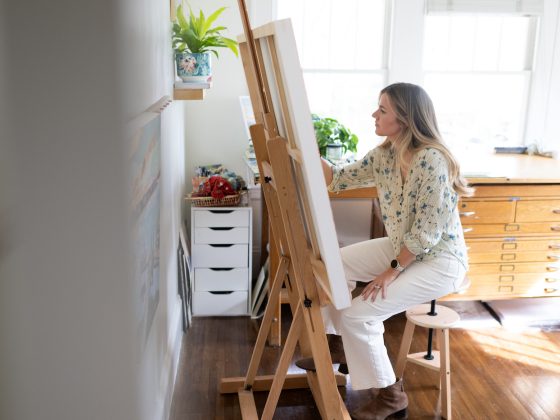Tom Stanley’s art deals primarily in dreamy abstractions, but the rest of his pursuits deal wholly in the – dare we say – bureaucratic real world.
A professional artist, he is also a longtime academic administrator. That dichotomy is one that challenges him at times – so many, he says, of the artists he admires most never attended arts school or boiled creativity down into quantifiable terms… But navigating dichotomies is what Tom Stanley is all about.
The North Carolina born artist currently lives in Rock Hill, SC. He’s the former chair of the Department of Fine Arts at Winthrop University, with an M.F.A. in Painting from the University of South Carolina and Stanley has been acting as a faculty member at academic institutions across the U.S. for years.
The pull he feels to the art world began very young, when he was given an oil paint set for a Christmas gift. Though he never took an art class before college, he did take mechanical drawing and architectural drawing, an experience that was nothing short of formative.
“It’s hard for anyone to deny that what happens when you’re very young has a tremendous impact on what happens when you continue to grow.”

Rhodes Photography.
His work now deals largely in geometrics, in a mainly black, white, and gray palette. His repeated use of sharp angles and meticulous lines reflects that early mechanical drawing. Now, Stanley often uses the sgraffito technique, a texture-heavy process of scraping away paint to reveal previously painted layers below. “I draw with paint,” he says, “rather than paint with paint.”
Your work is abstract, so tell us – what ‘real world’ things inspire you?
I think man-made structures, because I’m always making them also. When I’m working on a series, I’m really building those works so I look at them as “man-made” in many respects. They’re based upon man-made objects and so a lot of my work reflects that idea of something that’s been constructed.
Your work is certainly abstract, but do you consider yourself an Impressionist?
No, no. I don’t think I’m a part of anything. There are a lot of things I’m interested in, so I don’t want to be pigeon-holed.
What’s your favorite color to work with?
Black. A lot of my work is dominated by black or monochromatic colors. In large part, that’s because I’m more interested in the shape, the definition of the shape, and the edge, and the point of that is in respect to my interest in mechanical drawing. I am interested in the image as much as the color. I admit it, I’m not a colorist. But I do enjoy using it from time to time… Black and white – I like the contrast of those elements.
Do you have a preferred medium?
My preferred work is acrylic on canvas. Working in an environment where you have one job as a faculty member and administrator takes up a lot of time, so I set up projects for myself that allow me to go in, do something for an hour and then go to another job and come back later, so it allows me to continually work in some fashion, even though I’m not standing in front of the canvas all day long.

Rhodes Photography.
Can you describe your creative process a little bit?
When I work, I usually think of works in a series. I will begin the process by constructing or building a series of structures that are all the same size or work on paper that’s all the same size, and then I will put the first painted mark on one, and then go to the next and the next, almost like an assembly line. I think that that was influenced by another early job I had when I worked in the fashion industry in New York.a
I’ve noticed there are recurring figures in your work, like houses and boats.
I’ve always had an interest in boats, I’m not quite sure why. One thing that really solidified that interest was my genealogical research to find out something about my grandfather who drowned in the Mississippi in 1920. I tried to go to New Orleans to try and find some information on him… New Orleans is one of the largest ports in the world and that impressed me a great deal, seeing those ships just floating. What I enjoy about houses is, generally speaking, we all live in one.
Two houses are important to me: I had an accident and herniated a disc in my back in the 80’s. During the healing process, I began drawing rooms of the house I grew up in. I found that very therapeutic, and it also returned me to my interest of mechanical drawing because those were the tools I used when I was lying with my herniated disc. Also, my mother once ran a boarding house, so I would meet a lot of different types of people who would come and go from the boarding house and I think it impacted a lot of my thinking to this day.
Is there a message you try to convey through your art?
I think the most important thing that you can walk away with is to not lose sight of working with your hands and your eyes. It creates a different type of intelligence altogether. If nothing else, if someone enjoys my work, I hope that’s one message they leave with: We all have that ability to think with our hands and eyes.It’s in our DNA, so we have to continue to find ways to utilize that and it might be in new ways we haven’t thought of before… it’s what humanizes us. People have [created art] with their hands for thousands of years.
Last thing – you’re an academic arts administrator. Have you found that that has had an influence on your art at all?
Where you are and what you do has an impact on the work and I accept that fact. I try to not hide myself… sometimes I’ll paint in the hallway because I’ve run out of space. I always wanted to integrate what I was doing into everything else I was doing so [academia] didn’t become a separate life. I wanted it to all work together. Plus, I so enjoy being a department chair. I love the students, and I’m also always very fond of artists who are not academically-based. Being in academia allowed me to do a lot of things I wouldn’t have been able to otherwise.












